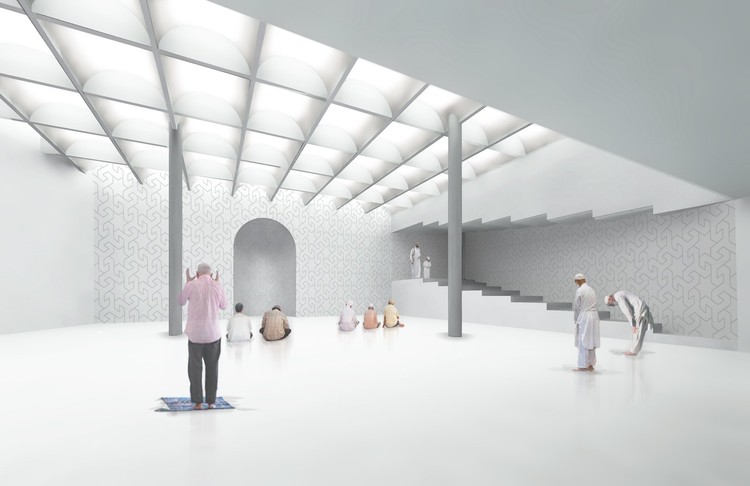
Studio Ö shared with us their first prize design, Room for Prayer, a mosque and cultural center as an extension for the Islamic Center of New England, Massachusetts. The proposed volume is closed to the outside and opens up on the inside. The intricate pattern of concrete facade works with shifting planes, creating shadow effects and an elegant and playful expression. More images and architects’ description after the break.
Volumes

By placing the new addition of the Islamic Cultural center next to the existing building we where able to set the parameters and proportions of the new part freely. The new building is raised above the ground by round, slender pillars. The volume is connected to the existing building by a passage, linking the new building to the communication of the existing one.
Communication

The existing entrance and staircase are perfectly placed to serve both the old and the new building. By adding an elevator in the kitchen supply room, opposite the staircase, we use the space in the best way, making the buildings accessible to everyone. By adding another flight of stair above the existing one and making the lift go all the way up, the second floor of the new building is accessible from the same communication area. The staircase receives light from the symbolic minaret that is placed on top of the staircase. The minaret lends the staircase a sense of airy space and the roof window gives it a beautiful light, which travels all the way down to the first floor.
New Building

Each gender has it’s own floor accessible from the existing building. The women continue to the second floor, while the men enter from the first floor. Once you enter the new building you enter a light and airy space. The light enters the inward facing building in interesting ways making it a unique and poetic place. The new building is facing Qibla internally, while its shell is adapted and subordinated the existing building and its surroundings. The exterior doesn’t reveal the space that opens up inside. This also symbolizes the way you turn inside when you pray and leave the outside world outside for a moment.
Prayer

Coming from the passage between the buildings you first pass the shoe racks. On your right there is an opening between the floors letting the light from a roof window flood down to the first floor. You now enter the ablution area, passing the toilets. The ablution areas connect to an inner, spiritual garden with lush vegetation, lending it light and a sense of freedom. Water flows continuously in narrow streams giving you the sensation of washing yourself in nature. The prayer room, which is one room or space with a mezzanine for the woman, is flooded by light trough a magnificent ceiling with lots of arched lanterns that distribute the light evenly. The wall facing Qibla houses the mihrab and on the right hand side the minbar is carved out of the wall. Both these walls are sparse but elegantly decorated with a relief of a traditional Islamic pattern.
Material and Construction

Concrete is a fantastic material that can be varied to create different expressions. The facades are made out of concrete planes with a chiseled surface. Inside the surfaces are much smoother and at times even polished, to reflect the light coming in from the lanterns in the roof and the windows facing the spiritual garden. On other parts it is treated with a relief surface to reflect a pattern. Different pigmentations are used to brighten the interior and make use of the light. The rough exterior is contrasted by the softer and more processed interior. The pillar deck construction is flexible and provides the possibility of using the interior space freely. The pillars lift the building from the ground and the parking and suspends the it in mid air creating an illusion of a floating solid.
Architects: Studio Ö Location: Quincy, Massachusetts, United States Type: Extension for Islamic Center of New England Status: First prize in open architecture competition hosted arcbazar Size: Approx 430 m²










